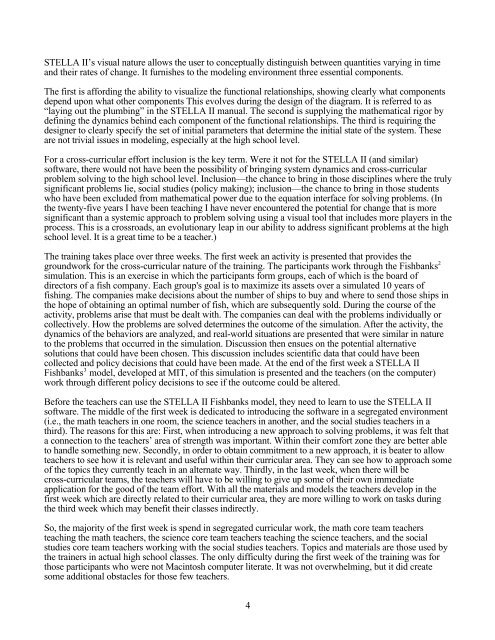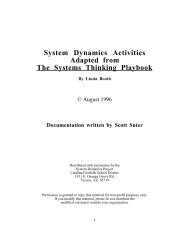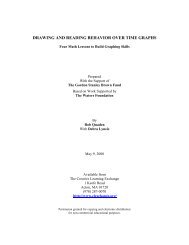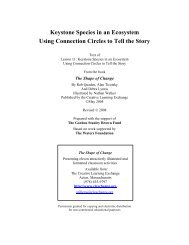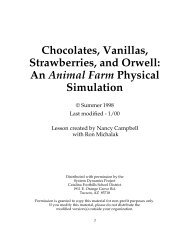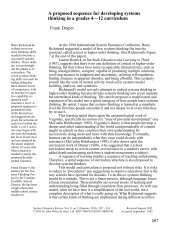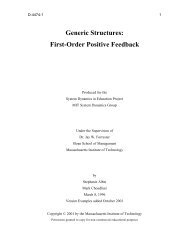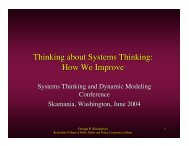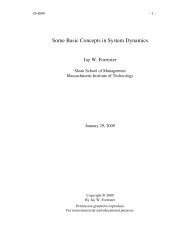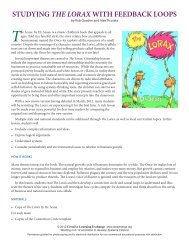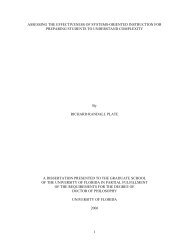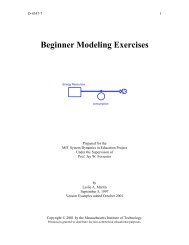Teaching System Dynamics to Teachers and Students in 8-12 ...
Teaching System Dynamics to Teachers and Students in 8-12 ...
Teaching System Dynamics to Teachers and Students in 8-12 ...
You also want an ePaper? Increase the reach of your titles
YUMPU automatically turns print PDFs into web optimized ePapers that Google loves.
STELLA II’s visual nature allows the user <strong>to</strong> conceptually dist<strong>in</strong>guish between quantities vary<strong>in</strong>g <strong>in</strong> time<strong>and</strong> their rates of change. It furnishes <strong>to</strong> the model<strong>in</strong>g environment three essential components.The first is afford<strong>in</strong>g the ability <strong>to</strong> visualize the functional relationships, show<strong>in</strong>g clearly what componentsdepend upon what other components This evolves dur<strong>in</strong>g the design of the diagram. It is referred <strong>to</strong> as“lay<strong>in</strong>g out the plumb<strong>in</strong>g” <strong>in</strong> the STELLA II manual. The second is supply<strong>in</strong>g the mathematical rigor bydef<strong>in</strong><strong>in</strong>g the dynamics beh<strong>in</strong>d each component of the functional relationships. The third is requir<strong>in</strong>g thedesigner <strong>to</strong> clearly specify the set of <strong>in</strong>itial parameters that determ<strong>in</strong>e the <strong>in</strong>itial state of the system. Theseare not trivial issues <strong>in</strong> model<strong>in</strong>g, especially at the high school level.For a cross-curricular effort <strong>in</strong>clusion is the key term. Were it not for the STELLA II (<strong>and</strong> similar)software, there would not have been the possibility of br<strong>in</strong>g<strong>in</strong>g system dynamics <strong>and</strong> cross-curricularproblem solv<strong>in</strong>g <strong>to</strong> the high school level. Inclusion—the chance <strong>to</strong> br<strong>in</strong>g <strong>in</strong> those discipl<strong>in</strong>es where the trulysignificant problems lie, social studies (policy mak<strong>in</strong>g); <strong>in</strong>clusion—the chance <strong>to</strong> br<strong>in</strong>g <strong>in</strong> those studentswho have been excluded from mathematical power due <strong>to</strong> the equation <strong>in</strong>terface for solv<strong>in</strong>g problems. (Inthe twenty-five years I have been teach<strong>in</strong>g I have never encountered the potential for change that is moresignificant than a systemic approach <strong>to</strong> problem solv<strong>in</strong>g us<strong>in</strong>g a visual <strong>to</strong>ol that <strong>in</strong>cludes more players <strong>in</strong> theprocess. This is a crossroads, an evolutionary leap <strong>in</strong> our ability <strong>to</strong> address significant problems at the highschool level. It is a great time <strong>to</strong> be a teacher.)The tra<strong>in</strong><strong>in</strong>g takes place over three weeks. The first week an activity is presented that provides thegroundwork for the cross-curricular nature of the tra<strong>in</strong><strong>in</strong>g. The participants work through the Fishbanks 2simulation. This is an exercise <strong>in</strong> which the participants form groups, each of which is the board ofdirec<strong>to</strong>rs of a fish company. Each group's goal is <strong>to</strong> maximize its assets over a simulated 10 years offish<strong>in</strong>g. The companies make decisions about the number of ships <strong>to</strong> buy <strong>and</strong> where <strong>to</strong> send those ships <strong>in</strong>the hope of obta<strong>in</strong><strong>in</strong>g an optimal number of fish, which are subsequently sold. Dur<strong>in</strong>g the course of theactivity, problems arise that must be dealt with. The companies can deal with the problems <strong>in</strong>dividually orcollectively. How the problems are solved determ<strong>in</strong>es the outcome of the simulation. After the activity, thedynamics of the behaviors are analyzed, <strong>and</strong> real-world situations are presented that were similar <strong>in</strong> nature<strong>to</strong> the problems that occurred <strong>in</strong> the simulation. Discussion then ensues on the potential alternativesolutions that could have been chosen. This discussion <strong>in</strong>cludes scientific data that could have beencollected <strong>and</strong> policy decisions that could have been made. At the end of the first week a STELLA IIFishbanks 3 model, developed at MIT, of this simulation is presented <strong>and</strong> the teachers (on the computer)work through different policy decisions <strong>to</strong> see if the outcome could be altered.Before the teachers can use the STELLA II Fishbanks model, they need <strong>to</strong> learn <strong>to</strong> use the STELLA IIsoftware. The middle of the first week is dedicated <strong>to</strong> <strong>in</strong>troduc<strong>in</strong>g the software <strong>in</strong> a segregated environment(i.e., the math teachers <strong>in</strong> one room, the science teachers <strong>in</strong> another, <strong>and</strong> the social studies teachers <strong>in</strong> athird). The reasons for this are: First, when <strong>in</strong>troduc<strong>in</strong>g a new approach <strong>to</strong> solv<strong>in</strong>g problems, it was felt thata connection <strong>to</strong> the teachers’ area of strength was important. With<strong>in</strong> their comfort zone they are better able<strong>to</strong> h<strong>and</strong>le someth<strong>in</strong>g new. Secondly, <strong>in</strong> order <strong>to</strong> obta<strong>in</strong> commitment <strong>to</strong> a new approach, it is beater <strong>to</strong> allowteachers <strong>to</strong> see how it is relevant <strong>and</strong> useful with<strong>in</strong> their curricular area. They can see how <strong>to</strong> approach someof the <strong>to</strong>pics they currently teach <strong>in</strong> an alternate way. Thirdly, <strong>in</strong> the last week, when there will becross-curricular teams, the teachers will have <strong>to</strong> be will<strong>in</strong>g <strong>to</strong> give up some of their own immediateapplication for the good of the team effort. With all the materials <strong>and</strong> models the teachers develop <strong>in</strong> thefirst week which are directly related <strong>to</strong> their curricular area, they are more will<strong>in</strong>g <strong>to</strong> work on tasks dur<strong>in</strong>gthe third week which may benefit their classes <strong>in</strong>directly.So, the majority of the first week is spend <strong>in</strong> segregated curricular work, the math core team teachersteach<strong>in</strong>g the math teachers, the science core team teachers teach<strong>in</strong>g the science teachers, <strong>and</strong> the socialstudies core team teachers work<strong>in</strong>g with the social studies teachers. Topics <strong>and</strong> materials are those used bythe tra<strong>in</strong>ers <strong>in</strong> actual high school classes. The only difficulty dur<strong>in</strong>g the first week of the tra<strong>in</strong><strong>in</strong>g was forthose participants who were not Mac<strong>in</strong><strong>to</strong>sh computer literate. It was not overwhelm<strong>in</strong>g, but it did createsome additional obstacles for those few teachers.4


